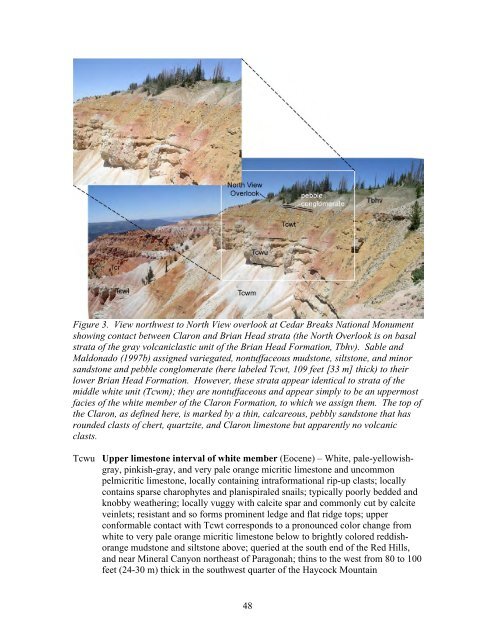Interim Geologic Map of the West Part of - Utah Geological Survey
Interim Geologic Map of the West Part of - Utah Geological Survey
Interim Geologic Map of the West Part of - Utah Geological Survey
Create successful ePaper yourself
Turn your PDF publications into a flip-book with our unique Google optimized e-Paper software.
Figure 3. View northwest to North View overlook at Cedar Breaks National Monumentshowing contact between Claron and Brian Head strata (<strong>the</strong> North Overlook is on basalstrata <strong>of</strong> <strong>the</strong> gray volcaniclastic unit <strong>of</strong> <strong>the</strong> Brian Head Formation, Tbhv). Sable andMaldonado (1997b) assigned variegated, nontuffaceous mudstone, siltstone, and minorsandstone and pebble conglomerate (here labeled Tcwt, 109 feet [33 m] thick) to <strong>the</strong>irlower Brian Head Formation. However, <strong>the</strong>se strata appear identical to strata <strong>of</strong> <strong>the</strong>middle white unit (Tcwm); <strong>the</strong>y are nontuffaceous and appear simply to be an uppermostfacies <strong>of</strong> <strong>the</strong> white member <strong>of</strong> <strong>the</strong> Claron Formation, to which we assign <strong>the</strong>m. The top <strong>of</strong><strong>the</strong> Claron, as defined here, is marked by a thin, calcareous, pebbly sandstone that hasrounded clasts <strong>of</strong> chert, quartzite, and Claron limestone but apparently no volcanicclasts.Tcwu Upper limestone interval <strong>of</strong> white member (Eocene) – White, pale-yellowishgray,pinkish-gray, and very pale orange micritic limestone and uncommonpelmicritic limestone, locally containing intraformational rip-up clasts; locallycontains sparse charophytes and planispiraled snails; typically poorly bedded andknobby wea<strong>the</strong>ring; locally vuggy with calcite spar and commonly cut by calciteveinlets; resistant and so forms prominent ledge and flat ridge tops; upperconformable contact with Tcwt corresponds to a pronounced color change fromwhite to very pale orange micritic limestone below to brightly colored reddishorangemudstone and siltstone above; queried at <strong>the</strong> south end <strong>of</strong> <strong>the</strong> Red Hills,and near Mineral Canyon nor<strong>the</strong>ast <strong>of</strong> Paragonah; thins to <strong>the</strong> west from 80 to 100feet (24-30 m) thick in <strong>the</strong> southwest quarter <strong>of</strong> <strong>the</strong> Haycock Mountain48
















